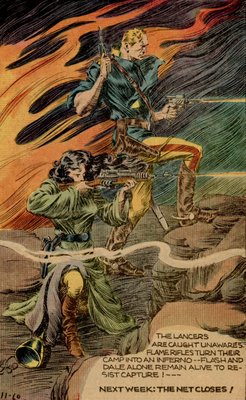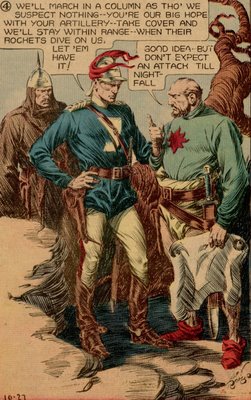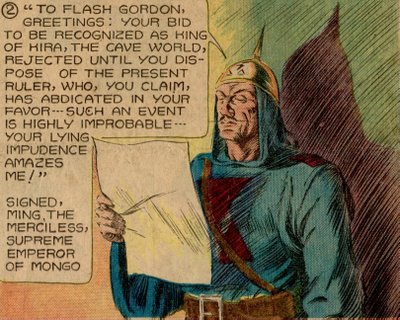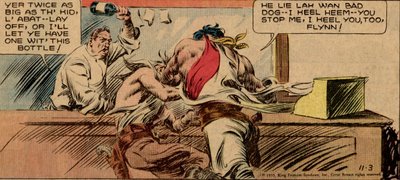
When the illustrator Robert Fawcett decided to abandon fine art for illustration, His painter friends objected that illustration was coarse, vulgar and tasteless. Fawcett responded that "good taste" is often the enemy of creativity:
the creative act in art involves a kind of courage which good taste might easily modify. It almost seems as if the creative impulse involves a large ingredient of vulgarity to be a vital statement. In drawing, an excess of what we think of as good taste can only result in an anemic product, while the more vulgar statement... is invariably stimulating.Pulitzer prize winner Michael Chabon sided with Fawcett, praising comic art as straddling "high art and low art [at] the margins of trash and quality....There's something stimulating about hanging out at the borders there."
One of the most marvelous inventions to spring from the borders of trash and quality was Alex Raymond's comic strip, Flash Gordon. These virile drawings with their gorgeous lurid coloring are from a Sunday page in 1935.



Unfortunately, vulgarity has few defenders left these days. The priests of high art have learned to tolerate many forms of marginal art but have never quite overcome their aversion to rocket ships and ray guns. Even illustrators who should know better often pull up the ladder behind them once they achieve some legitimacy. When Edward Sorel, a caricaturist of modest skill, had a show at the National Portrait Gallery he quickly changed uniforms. I asked his opinion of his fellow caricaturists at MAD magazine and he sniffed with derision, "those people are vulgar."
Once upon a time, vulgar (meaning uncouth and unrefined) art was not such a problem. The greatest works of western culture were filled with slapstick humor, violence and sex. Homer, Chaucer and Shakespeare are riddled with vulgarity. Chaucer, for example, loved flatulence jokes more than Howard Stern does. Here he writes about how a woman, after cheating on her husband with one lover, sticks her naked bottom out a window to trick a second suitor who is standing outside begging for a kiss in the night:
Dark was the night as pitch, aye dark as coal
And through the window she put out her hole...
With his mouth he kissed her naked arse
Right greedily, before he knew of this.
Aback he leapt-- it seemed somehow amiss,
For well he knew a woman has no beard...
And said, "Oh fie, alas! What did I do?"
Compared to Chaucer, Flash Gordon seems positively refined. I don't recall Dale Arden resorting to anything so uncouth. Yet, pale critics weighed down by too much history and too much taste look at the excess in Flash Gordon and recoil.


Vulgar art flourishes even without defenders for the best of all possible reasons: because its strength commands an audience. It is robust art in a great cultural tradition. Some of the best ideas come from just outside the borders of good taste, wearing a little too much rouge, and we should not be so quick to take offense .

Fine art or illustration. I can't decide which is more tasteless.
ReplyDeleteI agree with you, anonymous. When in doubt, I go with the one that is least pretentious.
ReplyDeleteEven the purveyors of vulgar art can fall victim to elitism: Some years ago at the San Diego Comic Con i approached Steve Rude and asked him if he ever considered doing illustration work in advertising.
ReplyDeleteYou'd have thought I'd just let a big smelly fart into the room.
"Why would I ever want to do advertising illustration?!" asked the student of Andrew Loomis before turning back to the large charcoal sketch of Elvis he was working on.
Go figure. ;-)
Your experience with Steve Rude is exactly like my experience with Edward Sorel, Leif. I think the artists who fear they are closest to the line are most obssessive about policing the perimeter. I have studied the originals of both Sorel and "vulgar" Mad artists like Mort Drucker and Jack Davis. In my view, Sorel doesn't come close.
ReplyDeleteIn talking with real giants like Bernie Fuchs, I have found they don't worry about the label "illustrator." They are quite comfortable with where they are. They let their work speak for itself.
Great article!
ReplyDeleteBeen loving your blog, very inspirational.
Thank you!
-T
Bless you!
ReplyDeleteMaybe Rude was just reacting to the overall sad state of Illustration these days. Being an illustrator (advertising or otherwise) back in the days of Bernie Fuchs or Loomis had to be more rewarding than it is today.
ReplyDeleteMaybe - but I suspect not, anonymous. I didn't want to retell part two of the Steve Rude story because it might sart sounding like a SR bashing and I actually really like his work - it was just a good example of the kind of thing David was talking about in his post. But here goes:
ReplyDeleteSeveral years later Rude and Mike Mignola were guests at a Toronto comic con and I took two good buddies, both advertising storyboard artists to meet them. My friends had long admired Rude and Mignola's comic art and brought along some of their own work, thinking they might have a bit of a tech talk with the two comic artists.
To my horror, Rude was down right rude to my friends, saying to them that storyboarding was for sub-talents who couldn't make it in comics. Mignola sat like a lump, not interested since they weren't slavering fan-boys.
Needless to say my otherwise mild-mannered friends gave Rude an earful, then pulled out their samples which, to his credit, Rude had to admit were of a quality he had not imagined.
These are tough times to be an illustrator - I say that from personal experience - but I suspect there were many journey-men illustrators back in the day who were not enjoying the kind of careers Loomis and Fuchs had.
"When in doubt, I go with the one that is least pretentious."
ReplyDeletePretentiousness being, of course, distasteful.
Having written about an illustrator of vulgar content (Enoch Bolles) I can attest that what is being described isn't a recent phenomenon. Bolles was a technical virtuoso who worked from the teens to the early 40s. He created hundreds of beautiful illustrations for products ranging from bread to cigarettes, but was most closely identified with his pinup work for Film Fun magazine and the pulps. He pushed the boundries of acceptable taste, and his his publishers occasionally did jail time or lost mailing priviliges to their magazines. Bolles eventually became Balkanized to the point where he could get no other work than for the Spicy pulps. At the same time less talented "glamour" illustrators who did more socially acceptable work were lauded by the press.
ReplyDeleteIf Sorel can't see the brillance of the Mad magazine guys, he's either stupid or blind. Or lying.
ReplyDeleteMy problem with rocketships and rayguns is that they are almost always adolescent escapist fantasies (as are pin-up drawings of half-naked come-hither girls).
There's more to life than adolescent escapist fantasies, but boys in the U.S. (including myself) loathe to give them up. (And I still love that stuff, but I wish it was smarter.)
The art world that you talk about (and that still is vastly powerful) is overly concerned with intellectual justification and not the work-itself. There's more to life than that, as we both know, but the art world is slowly changing.
Just as long as the art world doesn't turn into the comic book world (which thankfully, is changing too, and realizing there's more stories to tell than escapist boy stories).